Katie Rose Molina Browning and Scott Gallant
As we look to find niches and stack functions in our tropical permaculture homesteads, one often overlooked group of plants include the edible flowers. With a focus on Costa Rica, this blog, authored primarily by Katie Browning, a certified herbalist, explores the many common and uncommon edible flowers available to us in the tropics. Most of these plants fit comfortably within the principles of permaculture and they can be described by the following set of patterns:
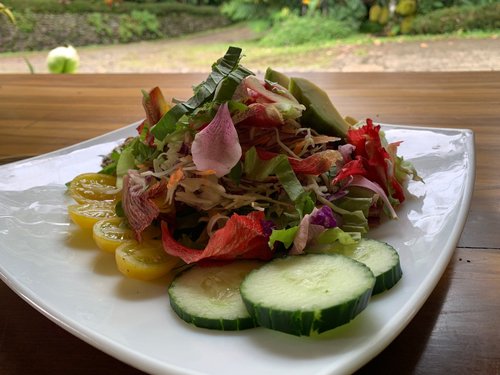
- Nearly all of these plants are perennial and can be described as perennial vegetables.
- Most feature strong medicinal qualities as well, hence our partnership with an herbalists to complete this list.
- All of these flowers bring relationships with pollinators, beneficial insects, and often result in delicious fruit if not harvested as vegetables.
- There use is either raw/fresh, as a cooked/steamed vegetable, or in herbal teas and beverages.
If you know of other edible flowers which should be on our list, please add them in the comments and we can grow this list together.
If you would like to see how edible flowers can be incorporated into your landscape and menu consider joining us for one of our upcoming Permaculture Design Courses!
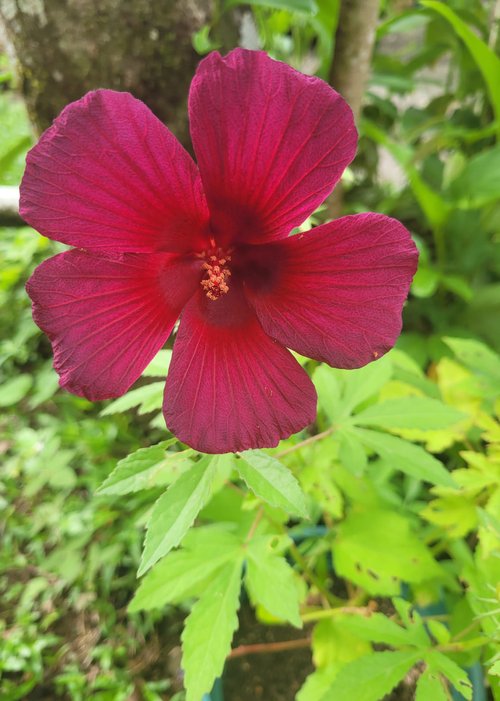
AMAPOLA
Common name: Amapola (Spanish) Hibiscus (English)
Latin binomial: Hibiscus rosa-sinensis
Blooms: All year
Flavor: Sour/sweet/juicy
An abundant and beautiful edible flower that you can find lining most yards and back roads in Costa Rica. It has a cranberry-citrus, nourishing flavor that is slightly sour, sweet and a bit juicy in texture. This juicy ‘goo’ is from Amapola’s very beneficial healing mucilage content which helps sooth all the mucous membranes in the body. It can be a beautiful garnish to a salad, as a decoration for special cakes and deserts, or as a side garnish of a main plate. As a tea, Hibiscus is tasty and helpful for the blood/circulation, digestion and for Women’s health issues. Amapola is typically red though varietals come in many different colors. Like many Malvaceae family flowers, many Hibiscus species are edible.
Cautions/Contraindications: Do not use (particularly in large amounts) if you are on Diabetes or HBP medication. Hibiscus can decrease blood sugar and blood pressure levels.

BEGONIA
Common name: Begonia (Spanish) Begonia (English)
Latin binomial: Tuberous- Begonia x tuberhybrida and Wax- B. x semperflorens-cultorum
Family: Begoniaceae
Blooms: All year
Flavor: Citrus/sour
These stunning flowering bushes are a common ornamental in Costa Rica, though are generally new to cultivation in Central America. The whole flower of both tuberous and wax Begonias are edible. The blossoms of the tuberous varieties have a lemony- citrus taste and the petals can be eaten raw and used in salads or fresh dishes as a garnish for the plate. The colorful blossoms can also add a creative and beautiful dimension to cocktails and refreshments! The wax varietals are more fleshy and can be consumed raw or cooked. With a crisp and moist texture they are wonderful for salads and sandwiches, added to soups or pasta dishes or used as a tasty and fun element for dips.
Cautions/Contraindications: Contains oxalic acid and should avoided by people with kidney issues, gout or rheumatism.

CARAO
Common name: Carao (Spanish) Carao Tree (English)
Latin binomial: Cassia grandis
Family: Fabaceae
Blooms: Beginning of dry season
Flavor: Green, slightly sweet
The seed pods of this beautiful flowering tree are well known in Costa Rica for a nutritive and medicinal infusion called ‘Miel de Carao’, commonly used for anemia and hemmoraging. The sweet pink flowers are the lesser known edible delight! These flowers add a nice element mixed in salads or can be added at the end of simmering a soup. Carao flowers contain some of the same properties as the seed pod and can add a nutritive element to your dishes.
Cautions/Contraindications: Use with caution during Pregnancy.

CLITORIA
Common name: Clitoria/Campanita (Spanish) Butterfly Pea (English)
Latin binomial: Clitoria ternatea
Family: Fabaceae
Blooms: Year round
Color: Blue, blueish purple and white
Flavor: Mild, slightly bitter and sweet
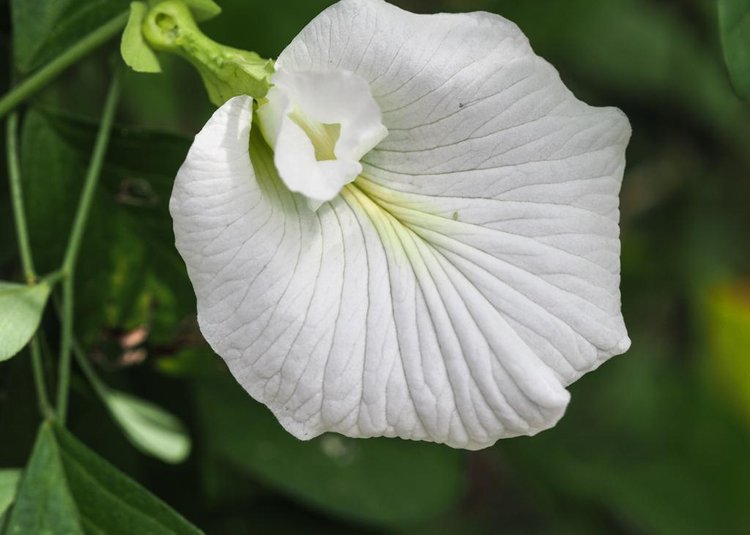
This sexy low climbing, vining plant brings beauty to your dishes alive with its gorgeous blue hues. Use it as a garnish in salads or as a natural colorant for cakes, rice, drinks and much more. Butterfly Pea can imbue a beautiful natural dye ranging from blue to green to magenta depending on the solvent used. Clitoria flowers are traditionally drank as tea, used in rice and also battered and fried in Asian cuisines. One of its most interesting uses is as a tea it can bring on lucid dreams. Aparajita or Koyala is very well known in India and in Ayurvedic medicine, particularly for the nervous and digestive systems. Clitoria alba is the beautiful white flowered cousin of Clitoria ternatea.
Cautions/Contraindications: Consumed in large amounts this flower may have Entheogenic properties. (Entheogens are psychoactive substances that induce alterations in perception, mood, consciousness, cognition, or behavior). The roots are an emmenagogue and should not be consumed by pregnant women.

CANA AGRIA
Common name: Cana agria (Spanish) Spiral Flag or Red Button Ginger (English)
Latin binomial: Costus woodsonii- Red Button Ginger AND Costus barbatus- Spiral Flag Ginger
Family: Zingerberaceae
Blooms: All year
Flavor: Sweet and juicy
These beautiful types of Costus Gingers are seen growing throughout Costa Rica and line both roadsides and beaches in particular. Pick the little yellow flowers that emerge from the red cone. They taste like nectar and I have been hooked ever since! Usually, I just like to nibble on them fresh as I walk past, but they can also be collected and used as a tasty salad garnish.
Like its cousin, common Ginger, the rhizomes of Cana Agria have many medicinal properties. The gorgeous white flower is also edible! It is crunchy, sweet and juicy and almost like a sugar coated candy, but as a beautiful flower version. I personally have had a hard time eating them beyond serving a decorative purpose, though they can also be chopped up and put in dishes.
Cautions/Contraindications: Do not take in medicinal doses during pregnancy.

COLA DE ALCARÃN
Common name: Cola de Alcarán (Spanish) Blue Porterweed (English)
Latin binomial: Stachytarpheta jamaicensis
Family: Verbenaceae
Blooms: All year
Flavor: Earthy, savory
This unique small flowering bush is commonly found along roadsides and disturbed wild areas. It is a fabulous pollinator plant and the flower of the wild purple species are edible and medicinal. Pick the little purplish blue flowers from the tail like portion and add to your salads or stir-fry. The best part is they taste like mushrooms! Adding them to other cooked greens helps imbue this flavor. An interesting traditional use of this plant is the leaves were used because of their bitter flavor and dark color to make beer, hence its English name Porterweed. Medicinally the benefits are vast and have an affinity for the digestive, respiratory and integumentary systems.
Cautions/Contraindications: Do not take during Pregnancy or while taking Blood Pressure medication Please Note: Eat the The BLUE flowering species only and not the common ornamental varietals that come in pink, purple and red. Do not mistake with Vervain- Verbena officinalis!

LOROCO
Common name: Loroco (Spanish)
Latin binomial: Fernaldia pandurata
Family: Apocynaceae
Blooms: All year. Particularly dry season
Flavor: Pungent, sweet, tangy
This woody, vining plant grows throughout tropical Central America and is a popular flower for consumption in El Salvador and Guatemala, with lesser known uses in other Central American countries. In general it is the unopened flower buds that are harvested and used much like a vegetable, eaten with rice or other traditional foods. Loroco has a lot of significance to local street foods and they are added to ‘pupusa’, a popular stuffed tortilla in El Salvador and in Guatemala they are an essential ingredient of ‘pollo en crema’, a rare and celebrated delicacy. If you are looking to just experiment, Loroco goes well with veggies like Zucchini, is good in pasta dishes, cooked in omelets, sprinkled in soups and is also wonderful with white cheeses! The flower buds are primarily used fresh and not found outside Central America though can be stored in fridge for a few days if needed. They can be dried, pickled or frozen. Locoro is a great source of fiber, calcium and is also high in niacin, vitamin A, C and iron.
Cautions/Contraindications: Unknown

MADERO NEGRO
Common name: Madero negro (Spanish)
Latin binomial: Gliricidia sepium
Family: Fabaceae
Blooms: Dry season
Flavor: Slightly sweet and green
This fast growing, beautiful tree is most commonly seen as living fences throughout Costa Rica. It serves as an important, inherently natural antifungal/insecticide and this pea family tree symbiotically fixes nitrogen into the soil. Madero negro is also planted as an ornamental and these lovely, light pink blossoms bless the roadsides, yards and fincas throughout the dry season when they can be picked for consumption. Many ‘Campesinos’, particularly in the mountain regions of Costa Rica, have traditional dishes where Madero Negro flower is used. The tasty, sweet and fresh green flowers are consumed in small amounts raw, such as a salad garnish though they are best when cooked. They can be added to many dishes such as a Picadillo con Huevos (see recipe below), with fish or chicken, and they can also be battered and fried. The whole plant has medicinal use – as a folk remedy for coughs/colds/fever and also as a topical remedy.Its antiparasitic properties make it a popular bath dip for animals.
1 kilo of flowers
6 Eggs
¼ cup each Culantro, Onion and Bell Peppers
Pinch of Paprika, Black Pepper and Cumin
Start with washing the flowers
Put in a pot of water and simmer over stovetop for 15 mins
Batter the eggs
Take cooked flowers and strain out water
Cook in pan with a with a little oil Bell Pepper, Onions and Culantro
Add in Flowers and Spices and mix
Then add battered eggs and scramble
Add salt to taste
Cautions/Contraindications: The leaves of the Madero Negro tree also have potential medicinal use, though all other parts of tree are considered poisonous and not for consumption.

PORO
Common name: Poro (Spanish)
Latin binomial: Erythrina poeppigiana
Family: Fabiaceae
Blooms: Height of dry season
Flavor: Fresh Green
This beautiful flowering tree can be seen gracing the landscape during the Costa Rican dry season and is often planted for shade around coffee plantations. It is used in a very similar manner to Madero negro in agroecological systems throughout Central America. It is an important precious wood as well as food. The edible flowers can be used in dishes like vegetables. They taste like green beans! Use in recipes where you would normally add green beans and be pleasantly surprised.
Cautions/Contraindications: Unknown

ROSA DE JAMACIA
Common name: Rosa de Jamaica (Spanish) Hibiscus (English)
Latin binomial: Hibiscus sabdariffa
Family: Malvaceae
Blooms: All year
Flavor: Sour/Tart
The calyx and flower of this well-known tropical beauty is a delectable edible and medicinal. A popular, delicious (albeit sugary) chilled drink in Costa Rica that nearly every household and restaurant serve, Rosa de Jamaica can be found throughout parts of Central America particularly the Caribbean. Native to West Africa, it has been globally naturalized in tropical areas throughout the world. Depending on the region or part of the world there are often spices added to the traditional tea drinks. In parts of the Caribbean islands, cloves, cinnamon, bay leaves, allspice and/or ginger are added, In Jamaica it’s often drank with Rum! Whereas, in its native West Africa the cold drink is made with mint leaves. A hot tea can also be made and whether hot or cold, Hibiscus sabdifera has many incredible medicinal benefits as well. It is rich in antioxidants and wonderful for the heart, blood and circulatory health as well as for immunity. Sorrel or Saril (Sah-reel), as it is known in English also imparts a vibrant reddish-pink dye and can color everything from the tea water to fabrics. In parts of Africa and Southeast Asia the calyces are also used in jam preserves. This edible flower is a must taste for even the most hesitant!
Cautions/Contraindications: Do not use (particularly in large amounts) if you are on Diabetes or HBP medication. Hibiscus can decrease blood sugar and blood pressure levels. Use caution during pregnancy if it is put with other spices.
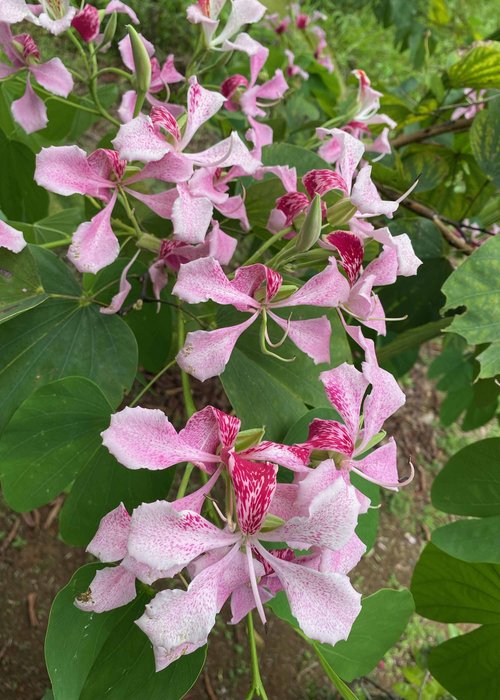
PATA DE VACA
Common name: Pata de Vaca o Arbol Orquidea (Spanish) Buterfly or Orchid Tree (English)
Latin binomial: Bauhinia purpurea or variegata
Family: Fabaceae
Blooms: All Year
Flavor: Bitter when Raw, Eat Cooked. Leaves have citrusy/sour taste
This beautiful flowering tree is a very popular ornamental tree in tropical and subtropical regions throughout the world and attracts pollinators like hummingbirds, though it has become invasive in some areas. At least nine Bauhinia species have edible parts and it is worth noting a new endemic species was discovered in Costa Rica/Panama in 2018, however Bauhinia proboscidea has not been researched as edible (yet!). The young leaves, flowers, nectar, seeds and seed pods can be eaten like a vegetable. While some Ticos know of the edible flowers, most knowledge of the edible usage stems from India and parts of Asia where flower buds are often pickled, cooked or made into a chutney. For instance, Kachnar is a local name in the Indian subcontinent for the edible buds collected from the tree and it is used to make traditional kachnar curry, prepared using kachnar buds, yogurt, onions and native spices.
A Great traditional recipes for cooking with Bauhinia from traditional Indian and Nepalese cuisine can be found here. The orchid tree also has many traditional medicinal uses particularly in Asian and Ayurvedic medicine. In scientific studies Bauhinia has been shown to have exciting antioxidant and anticancer properties.
Cautions/Contraindications: Caution leaves and flowers contain laxative properties. Other parts of the plant are medicinal but only in controlled amounts.
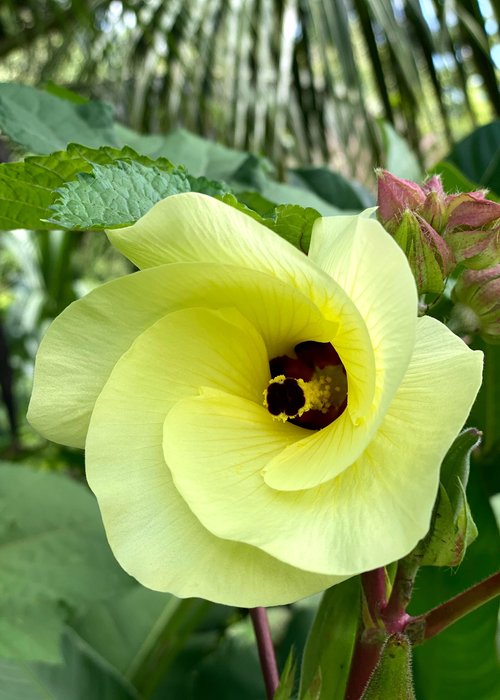
OKORO
Common name: Okoro or Ochoro (Spanish) Okra (English)
Latin binomial: Abelmoschus esculentus
Family: Malvaceae
Blooms: Dry season
Flavor: Green and juicy
If you don’t fancy the slimy texture of Okra, give the flower a try! The green seed pod of this Mallow family plant is well known in the Southern US, India and parts of Africa, however a lesser known edible part of the plant is the flower. Okra flower can be stewed or fried similar to the seed pods and taste similar to asparagus. Or, for a fresher flavor add the chilled blossoms to a salad. The flowers can also be dried and used as a tea, which offers similar benefits as Hibiscus to cool and sooth digestive system. Picking the flowers especially when there is an abundance of pods can help to keep the mass of woody dried pods at bay.
Cautions/Contraindications: Use caution similar to Hibiscus
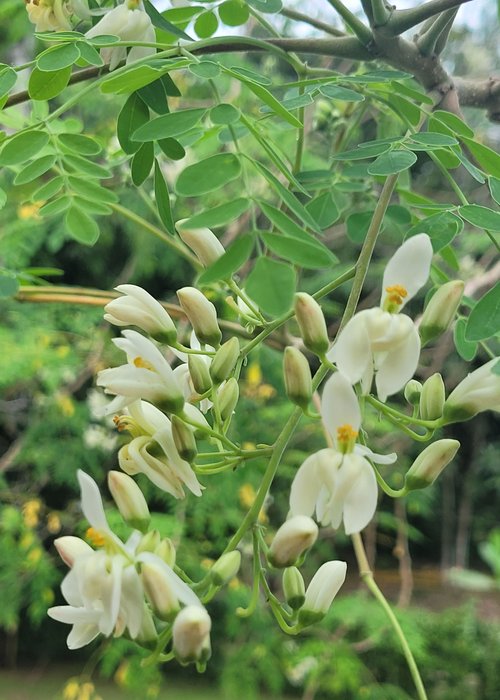
MORINGA
Common name: Moringa (Spanish) Drumstick Tree (English)
Latin binomial: Moringa olifera
Family: Moringaceae
Blooms: Dry season
Flavor: Fresh, pungent and a hint of spice
This gorgeous fast growing, drought resistant tree from the Indian subcontinent has recently become a popular tree to plant due to its incredible range of benefits as a food, medicine and regenerative crop. A true Mother tree, it is also one of the most nutrient dense plants in the world. Beyond what you may have already heard about its popular leaf and seed powder for a vast array of medicinal uses, what is commonly unknown in the Western world is that its flowers also carry dynamic uses as a food and medicine. These precious white beauties that bloom with abundance during dry season are first and foremost delicious! Pick one and try! From the first burst of fresh green to the end hint of spice, Moringa flowers carry enough flavor to be eaten by themselves. They also have a long history of use in Indian and African dishes, in which multiple scrumptious recipes can be found.
Being a serious Indian food lover one of my personal favorites is Sojne phool bati chorchori, a Bengali Drumstick tree flower curry!
I also love just experimenting and enjoy Moringa flowers in my tropical version of a salad, which includes the Moringa leaves as well. Seriously, I can’t imagine a dish like salads, stir-fries and curries, that would not be better with an addition of Moringa flowers. To top it off, Moringa flower tea is delicious and carries benefits for nearly every body system particularly the digestive, immune, and nervous systems. Drink hot or cold for all the nutritive and supportive benefits.
Cautions/Contraindications: Moringa has potential interactions with Thyroid, Diabetic and High Blood Pressure medication.

MARACUYA
Common name: Maracuya (Spanish) Passionflower (English)
Latin binomial: Passiflora edulis (most common edible fruit species) or incarnata (most common medicinal species)
Family: Passifloraceae
Blooms: Can bloom year around in tropics after the vine is established
Flavor: Green
This exotic tropical beauty is one of my all favorites as a medicinal, and its flower is edible too! Passionflower is a beautiful garnish for deserts and drinks that are bound to impress. It can also be used in salads to add a mild vegetable taste with a big show, or as a topping centerpiece on a main dish. To harvest make sure you find flowers that are wide open and cut at the base of the stem at the back of the flower. To enjoy both its edible and medicinal benefits it is best made into tea; the flowers, leaves and tendrils can be used for this either fresh or dried and steeped at least 15 mins. The unique flavor will also leave your nervous system and digestion supported and relaxed.
Cautions/Contraindications: Do not take Passionflower in medicinal doses if you are on antidepressants or sleep medication.
Edible Flowering Fruit Trees
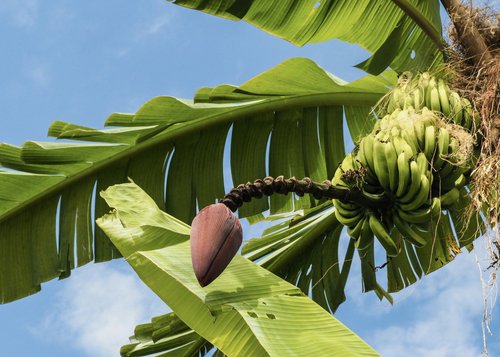
BANANO
Common name: Banano (Spanish) Banana (English)
Latin binomial: Musa paradisiaca
Family: Musaceae
Blooms: Blooms and fruits only once and grows to full in 12-15months
Flavor: Mildly Bitter (unless prepared or cooked).
The incredibly unique and phallic Banana blossoms are also known as the Banana hearts. Once you see one in person you will never look at this herb (not actually a tree) the same! While much of the world shares in the obsession of partaking of the sweet fruit, the blossoms are also a treat and can be eaten both cooked or raw. If you consume raw make sure to find a non-bitter variety. After harvest, the tough purple outer covering is removed and the tender white part of the blossom is exposed. This is then sliced and let sit in water to leach the sap. Try the tender white blossom chopped with things like shredded Papaya and Carrots for a yummy salad. It has the texture of bamboo shoots or heart of palm. Cooked Banana flowers have deep tradition in South Asian cuisines. They can be chopped and added to soups and stir-fry or steamed and peeled like artichokes to be used with dips. Banana flowers a nutritionally rich in fiber, potassium, calcium, phosphorus, iron, magnesium and vitamin E.
Here is a recommend resource on exactly how to harvest, prepare, and cook with the flowers.
Cautions/Contraindications: There are potential contraindications of eating Banana (in any form) for persons who have kidney or liver disease.
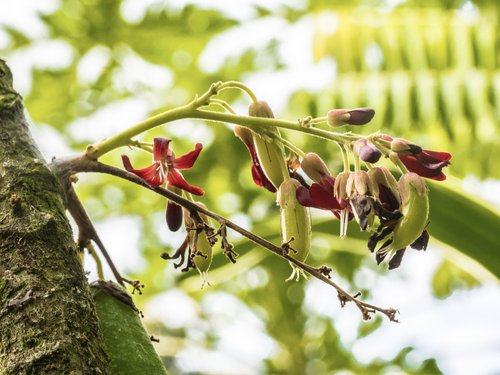
BILIMBI
Common name: Bilimbi (Spanish) Bilimbi (English)
Latin binomial: Avvorhoa bilimbi
Family: Oxiliadaceae
Blooms: Beginning of dry season
Flavor: While the fruit is very tart, the flower is only mildly sour
The flowers of this interesting fruiting tree closely related to Carambola (Starfruit) are both edible and medicinal. The blossoms are sometimes picked and added to the uncooked Bilimbi fruit and prepared as a tart relish to serve with main dishes like rice and beans. They also can be preserved with sugar for a sweet edible décor to deserts and pastries. Medicinally the flower infusion has traditional folk use for coughs and thrush.
Cautions/Contraindications: This oxalate rich plant should be generally avoided by those with kidney disease, gout or rheumatic conditions.

CARAMBOLA
Common name: Carambola (Spanish) Starfruit (English)
Latin binomial: Averrhoa carambola
Family: Oxiladaceae
Blooms: Beginning of dry season
Flavor: Sweet-Sour
This is a sweet pink flower of the commonly known tree that produces the yummy Carambola or Star Fruit. It is well known for its edible fruit though it also has scrumptious edible flowers and leaves! The raw flowers can be used to tang a great salad or processed to make a conserve.
Cautions/Contraindications: Contains oxalates and should be avoided by people with kidney problems.

MANGO
Common name: Mango (Spanish) Mango (English)
Latin binomial: Mangifera indica
Family: Anacardiaceae
Blooms: Dry season
Flavor: Fresh
While most of us are very familiar with the flesh of Mango fruit, have you ever thought of tasting the flower?! While not the sweet and rich flavor of the fruit, Mango flowers taste very refreshing and have many uses. The fresh flowers are an excellent addition to salads to enjoy on a hot summer day. Young Mango leaves and flowers can also be boiled and added to dishes like soups. To receive both the scrumptious and beneficial aspects of the flower, try making into a cool infusion by soaking the flower overnight in cold water, straining and then refrigerating a few hours before drinking. This yummy ‘agua fresca’ cools the body and is beneficial for inflamed digestive issues and headaches.
Cautions/Contraindications: Please Note! Mango is in the same family as Poison Ivy and some people have a severe allergy to Mangos, which also transfers to ingesting the flower. If you are allergic to Cashews, which is also in the botanical family, take warning as you are also most likely allergic to Mangos.
Additional Edible Flowers
Albahaca-Basil – Occimum basilicum
Marigold- Tagetes errecta
Nasturtium – Nasus tortus
Purslane – Portulaca oleracea
Ayote – Squash blossoms – Curcubita spp.
Amaranth – Amaranthus sp.
Violet – Viola sp.
Camerón Rojo – Odontonema tubaeforme
Note the following list is from PanClandia. Our team has not done the investigation on these flowers.
Malviscus arboreus
Thumbergia alata
Thumbergia erecta
Thumbergia grandiflora
Camellia japonica
Rubus rosaefolius
Cosmos caudatus
Zinnia sp
Tagetes patula
Impatiens walleriana
Peumus boldus
Kalanchoe fedtschenkoi
Bidens pilosa
Cosmos sulphureus
Cosmos sulphureus
Gomphrena globosa
Celosia argentea
Bougainvillea sp
Lonicera japonica
Abutilon darwinii
References and Links:
Books
- Rodriguez Navas, Hernan- La Utilidad de las Plantas Medicinales en Costa Rica
- Zuchowski, Willow – Tropical Plants of Costa Rica
- Pucchi & Gamboa- Arboles Magicos Costa Rica
- McIntyre, Anne – Flower Power: Flower Remedies for Healing Body and Soul
Online
- www.kew.org/science/collections-and-resources/data-and-digital
- hwww.edimentals.com/blog/
- www.eattheweeds.com
- www.mobot.org/mobot/plantmap/
- www.indianmedicinalplants.info/
- www.maya-ethnobotany.org/
- www.netmeds.com
- www.thespruceeats.com
- www.holisticlivingschool.com
- www.chestnutherbs.com
Permaculture Design Course
Check out our PDC this October 02nd-15th, 2023 if you want to taste all of these edible flowers!



